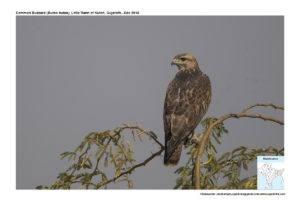Common Buzzard

Common Buzzard Buteo buteo
Etymology:
- Buteo : Latin word for Buzzard
- Buteo : Latin word for Buzzard
Vernacular Names : Hindi: Samanya Chuhamar, Lepcha: Dang pang ti on, Pang ti ong nok, Guj: Rana teeso, nano tiso, Ta: Ukussa, Mal: Parundu, Mar: Samanya baj
Distribution in India: Widespread Winter visitor but no certain area status in India
Description: Size of 40–52 cm; Wt. of male 427–1180 g, female 486–1360 g; wingspan 109–136 cm. The plumage is extremely variable. It is generally dark brown above and on most of underbody and underwing coverts; from below, wingtip and trailing edge of wing are dark, flight feathers are barred, pale area in outer primaries. The juvenile lacks broad band at tip of tail. The dark band along trailing edge of wing is less noticeable; generally paler and streaked on underparts. Races separated on size, colouration and plumage pattern. Nominate race highly variable in amount of brown, black, and white in plumage but generally with little rufous; race vulpinus normally smaller, often with rusty underbody, underwing coverts and upperside of tail, faintly barred tail.
Habitat: It is found in wide spread area, highly variable, but almost always with some degree of tree cover that is required for nests and roost sites. Prefers edges of woods and areas where cultivation, meadows, pastures or moors alternate with coniferous or deciduous woods, or at least clumps of trees. In winter, ranges into areas with very few trees, e.g. open fields, steppe or wetlands. Mainly flat terrain or gentle slopes at low or moderate elevations (sea-level–2000 m); also in mountains, where in summer may forage above tree line. Regularly perches on trees, poles, posts, rocks and pylons
Food Habits: It eats different prey types, according to local and seasonal availability. Essentially a hunter of small mammals, which often constitute up to 90% or more of prey; particularly rodents, with voles main prey over much of range; also mice, rats, hamsters, shrews, moles, young rabbits and hares; where abundant, rabbits can be locally important. Sometimes invertebrates dominate prey items by number like beetles, crickets, locusts and earthworms; reptiles locally important, including lizards, slow worms and snakes; few amphibians. Birds can be important by mass, particularly when mammals are scarce; occasionally, species up to size of pigeon, pheasant, partridge and Common Barn-owl are taken. At times scavenges carrion. Hunts in clearings and open areas near edges of woods; almost always captures prey on ground. Spends long periods perched, scanning or loafing; also spots prey from gliding or soaring flight; sometimes hovers or hangs on wind; also walks on ground when stalking invertebrates..
Breeding Habits: They breed in Mar-May. Normally nests in large tree, fairly close to edge of wood; occasionally on cliffs. Nest is bulky platform of sticks and twigs, lined with greenery; nests of other raptors sometimes used; each pair normally has several nests, switching to a different one each year. Normally 2–4 eggs per clutch are laid; incubation 35 days, mainly by female; male brings food at first, once chicks are 3 weeks old both parents feed them; chicks fledge in about 50–60 days; attain independence 6–8 weeks later. They are ready to breed in 3 years
.